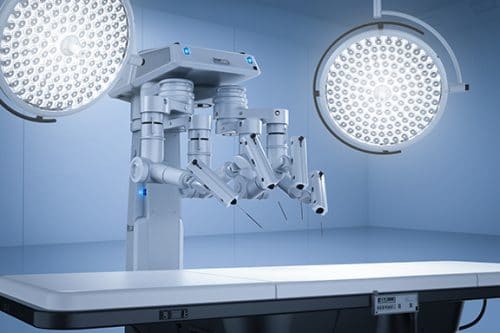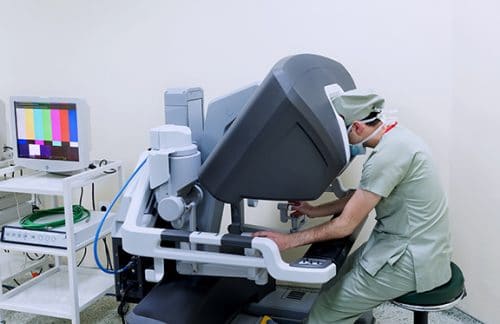20 years ago, a prostatectomy (the surgical procedure to remove part or the entire prostate) involved a large incision, blood loss, long hospital stays, long recovery periods, and a high risk of incontinence (due to the potential nerve damage and sphincter reconnection with the bladder). Today, Urologists, like Dr. Mani Menon, have significantly improved patient outcomes by using computer-assisted robotic surgery that is “nerve-sparing”. These improvements in surgical methods have significantly reduced the side effects of prostate surgery, including incontinence.

Open Prostatectomy
Prostatectomies have been performed as a treatment for prostate cancer for at least one hundred years. Open prostatectomy was the standard surgical procedure for much of that time. An open prostatectomy is a hands-on surgical procedure done by a Urologist to remove part or the entire prostate. An open prostatectomy involves an 8 to 10-inch incision in the abdomen, near the belly button. The surgeon then opens the persons’ pelvic cavity to expose the bladder and prostate and performs the surgery, using their hands and medical equipment.
Want to learn more about the Open Prostatectomy? Watch this animated video. Warning: Although this video is animated, it may be graphic for some viewers.
Computer-Assisted Robotic Prostatectomy

Since the early to mid-2000s, Computer-Assisted Robotic Prostatectomy has become the new standard. With Computer-Assisted Robotic Prostatectomy, 5-6 small incisions (a few centimeters each) are made in the abdomen and small robotic arms and an HD video camera are inserted. The surgeon uses a sophisticated machine to control the robotic arms inside the body. These controls and machines are extremely precise and allow the surgeon a level of precision and ability that is far beyond what can be done in an Open Prostatectomy.
Computer-Assisted Robotic Prostatectomy has demonstrated significant improvements in patient outcomes. Patients experience less pain, less blood loss, lower risk of infection, shorter hospital stays, and quicker return to normal activities. Additionally, Computer-Assisted Robotic Prostatectomy has significantly reduced the risk of developing incontinence after surgery and improved the recovery of normal urinary function.
Learn more about Computer-Assisted Robotic Prostatectomy (animated video). Warning: Although this video is animated, it may be graphic for some viewers.
What is Nerve-Sparing and Why is it Important?
There are many nerves in the urinary system, and they all work together to ensure the bladder and urinary tracts are functioning properly. These nerves communicate with the brain and inform the body when to urinate and when not to urinate. If certain nerves are damaged, the messages are not being delivered, and bladder control can become an issue. During prostate surgery, there is a high risk of nerve damage due to the complex anatomy of the bladder, prostate, and sphincter. Nerve-sparing surgeries are extremely precise procedures that remove the prostate while being particularly focused on maintaining nerve function. Nerve-sparing literally means “sparing nerve damage” during surgery.
Nerve-sparing surgeries are important because it reduces the risk of incontinence, erectile dysfunction, and other complications. Computer-Assisted Robotic Prostatectomy is considered a nerve-sparing surgery because of the precision and ability of the fine robotic instruments to spare the nerves while successfully removing the prostate.
The Risk of Incontinence
While the risk of incontinence has been significantly reduced as a result of surgical improvements, there remains a risk of temporary and permanent incontinence following a prostatectomy. According to the Cleveland Clinic, 6% to 8% of men will develop urinary incontinence following a prostatectomy. For most men, normal urinary function returns within one year after surgery. In rare cases, muscle or nerve damage may occur that can cause permanent incontinence.
For men experiencing incontinence after prostate surgery, the Tranquility Male Guard is the best solution for light to moderate leakage. The Tranquility Male Guard is designed with a cup shape to fit the male anatomy while creating a barrier against leakage. It features 9.5 oz. of absorbent capacity, so it will protect better than most products in its class. The guard is worn in traditional underwear by utilizing the product’s adhesive strip on the back. It is easy to use and discreet under clothing. If you are dealing with incontinence following a robotic surgery, or are getting ready to have a prostatectomy, trust Tranquility to keep you protected while you work with your Urologist to solve your condition.
Disclaimer: This blog provides general information about incontinence, health, and related subjects. The content in this blog, and any linked resources, are not intended and should not be taken as medical advice. If you or any other person has a medical concern, please consult a licensed physician.
Related Posts: